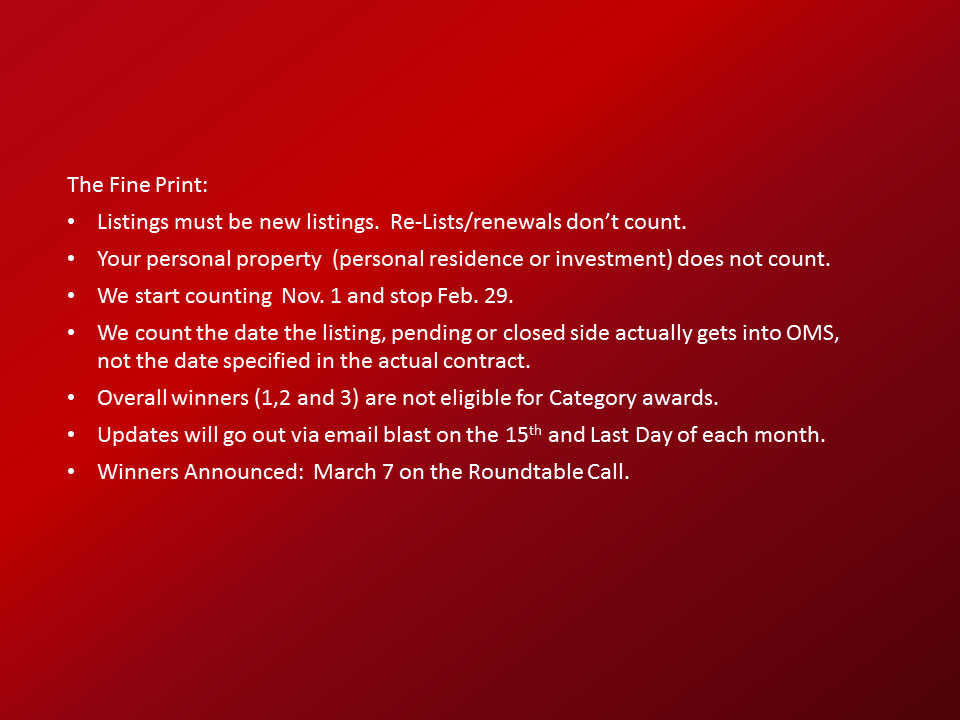


Exploring alternatives to the Status Quo in real estate



 We are Help-U-Sell. We don’t play by the rules. Ordinary brokers don’t get us (thank goodness!). They think the reason they lose business to us is because we cost less . . . which is only the tip of the iceberg. They lose business to us because we cost less and are a better choice for consumers. Getting more business is not a sales challenge for us. Because our program is better, it’s an educational challenge. Time and time again we learn that if we just get the word out into the marketplace that: 1) We are Here 2) People use us 3) It works, and 4) They save thousands, our business grows.
We are Help-U-Sell. We don’t play by the rules. Ordinary brokers don’t get us (thank goodness!). They think the reason they lose business to us is because we cost less . . . which is only the tip of the iceberg. They lose business to us because we cost less and are a better choice for consumers. Getting more business is not a sales challenge for us. Because our program is better, it’s an educational challenge. Time and time again we learn that if we just get the word out into the marketplace that: 1) We are Here 2) People use us 3) It works, and 4) They save thousands, our business grows.
Still, we live in a hostile environment. Our competitors outnumber us and sometimes we hear their internal dialogue more than we hear our own. It’s easy to fall into the trap of believing what they say about us, about the industry, about how to go about being successful. Symptoms of paying attention to the wrong voice(s) include:
What do you think? Does that ordinary broker bear-trap have you by the ankle?
Stop for a moment. Remember: You are not ordinary. You are a Guerilla. Let me remind you what that means:
1. You understand that the first and probably most important rule of marketing is to be visible. That means you will do almost anything to establish your brand in your marketplace. You’ll do what Patrick Wood – who is  one of our top producing brokers – does: You’ll fill your pick-up truck with dozens and dozens of directional signs and you’ll put them out all over the marketplace on Friday afternoon, taking them down Sunday evening. You’ll buy cheap, flimsey ‘Blitz’ signs that do little more than present your logo and tack/staple/tape them up all over your marketplace. You’ll refresh them every 4 to 6 weeks. You’ll wrap your vehicle and park it where it will be seen by the largest number of people. You’ll sponsor a Little League team or a Fun Run, getting your logo on the shirts. You’ll invest in billboards and bus benches. You will wear Help-U-Sell logo apparel and/or a logo name badge everywhere you go. You will not be invisible!
one of our top producing brokers – does: You’ll fill your pick-up truck with dozens and dozens of directional signs and you’ll put them out all over the marketplace on Friday afternoon, taking them down Sunday evening. You’ll buy cheap, flimsey ‘Blitz’ signs that do little more than present your logo and tack/staple/tape them up all over your marketplace. You’ll refresh them every 4 to 6 weeks. You’ll wrap your vehicle and park it where it will be seen by the largest number of people. You’ll sponsor a Little League team or a Fun Run, getting your logo on the shirts. You’ll invest in billboards and bus benches. You will wear Help-U-Sell logo apparel and/or a logo name badge everywhere you go. You will not be invisible!
2. You will build a strong case for seller involvement when you take listings. You will coach your sellers to show the property themselves and to hold their own open houses. You will provide them with ample open house directional signs and help them select the best locations for them. You will teach them how to get contact information on everyone who comes into their home and to transmit that contact information to you for followup. You’ll do all this because a) their involvement boosts your visibility b) their involvement generates more buyer leads for you and c) their involvement gives them the best shot at saving the most money.
3. Whatever you do for marketing will be a system. That means you choose your marketing vehicles carefully and you track the leads each creates. You are clear that you are not trying to sell a particular home with advertising, you are creating a flow of leads into the office that will benefit ALL of you listings. Your marketing system does vary from time to time, but once it is established it stays pretty much the same, month in and month out.
4. You are crazy enough to explore and exploit new media. You do a little Facebook pay-per-click directed at homeowners in your marketplace. You become a premium member of Zillow or Trulia. You set aside 90 minutes a week to work on the continued refinement and optimization of your website. You KNOW what tools your MLS has that you can use with consumers to make their home search process easier. You use QR codes and include a virtual tour with every listing.
process easier. You use QR codes and include a virtual tour with every listing.
5. Whenever you can, you get together with your fellow monkeys to share ideas, brainstorm, solve problems and learn. Of course there are at least two opportunities for this every week. On Tuesdays from 11am Pacific until noon, we have Tech Time, focused on exploiting the power of the Internet to build your brand and your business. Wednesdays from 9am Pacific until 10am, we have the Broker Roundtable call which always features a gem or two of relevant new information and lively conversation about what’s happening, what’s working, what’s not and so on.
6. YOU ATTEND THE UPCOMING HELP-U-SELL SUCCESS SUMMIT, Nov. 14-16 in Anaheim, CA.
One of the most powerful things about being Help-U-Sell (and if you are a broker or associate in a Help-U-Sell office, you are Help-U-Sell) . . . one of the most powerful things is that we are different. We don’t look, act, talk,or play the way the other barnyard animals do. We swing from trees, we have fun, we scheme and plot, and we make things happen. Unlike the cows, chickens and sheep scratching, chewing and pecking their way through yet another day, we are not waiting for everything to go back to normal. We are inventing the new normal even as we speak!
(p.s. I really do know how to spell Gorilla)
The Help-U-Sell Success Summit is just a few days more than a month away and I, for one, am really excited. We have an action packed agenda – lots of sharing and networking, of course, and special sessions with Nick Taylor from Zillow and real estate finance expert, Patricia Boyd. There will be top secret mystery announcements and unveilings and it will all happen at an energy level that will leave you glowing. Be sure to register for this free event by going to www.helpusellfranchise.com, clicking on the ‘Seminars’ banner and selecting ‘Success Summit’ from the drop down menu.
The Summit takes place November 14-16, immediately following the NAR annual convention taking place just down the street at the Anaheim Convention Center. We did that bit of scheduling on purpose because we are exhibiting at NAR and would love to see as many of our family members there as possible. The NAR meeting also offers tremendous learning opportunities for everyone. If you’ll click HERE, you can get an advance look at the agenda for that meeting. There is a charge to attend the various meetings and educational sessions, but admission to the Expo is free to REALTORS. Ron McCoy also has a limited number of passes to the Expo for non-REALTOR guests.
Bottom line: make your plans today! Definitely be at the Summit . . . and if you can come in a day or two early, take in NAR as well!
That last post has me pre-occupied. I think the two graphs and the statement by Yun are dramatic. I keep asking, ‘How can this be? How is it in a time when most Americans have taken a 50% or more hit on their home equity (which is, for most, the biggest nest egg they have), that the Financial Industry is doing so well?’ I mean: aren’t these the guys who got saddled with all of these upside down loans who now have to cash them out for far less than they have in them? How is it they can be so profitable at a time like this?
I don’t claim to be an expert. I certainly am not. I tend to see complicated things simply, often missing the many nuances. And I don’t know the big answer to the question, HOW. But I know one of the ways. When Banks were failing right and left, the FDIC stepped in seized the assets and guaranteed the deposits (thank goodness!). Because the FDIC is not in the banking business, they then turned around and sold those assets to other banks. Among the assets were usually a big stack of bad loans, mortgages where the property was worth far less than the amount of the mortgage. Wow! How do you get somebody to buy something that’s worth-less? How about incentives and discounts.
So let’s assume that Bank A fails. The FDIC steps in and seizes the assets, including one $300,000 mortgage on a property currently worth $250,000. They then sell that mortgage to Bank B for $235,000 – which is the discount part (since the property is worth $250,000, they transfer the asset at a discounted value that makes sense to Bank B). Here’s where the incentive part comes in. Because we are in a declining market, the FDIC goes on to guarantee Bank B’s losses on the mortgage. They say, if you take a loss on this loan, we’ll cover you up to 80% of your losses. Hey, now this is sounding a little safer, a little better.
So Bank B goes on and forecloses on the mortgage (let’s not even consider the impact on the foreclosed family, their neighbors, area values and the economic climate). They ultimately sell the property for $220,000 to an investor. So you think: they paid $235,000 and got $220,000. That’s $15,000 in loss and the government is going to cover 80% of that, which is $12,000, so Bank B’s net loss on the deal is $3,000. That’s ok, we all have to do our part, and they probably made a little on servicing or something.
But that’s not the way it works. The ‘loss’ is calculated NOT from what Bank B paid for the asset but from the face value of the asset: $300,000. The ‘loss’ is the difference between $300,000 and $235,000, $65,000. And 80% of that is $52,000. Bank B gets $220,000 when they dispose of the asset plus $52,000 from the government (which is, by the way, you and me), so their take is $272,000 on a thing they paid $235,000 for: a net of $37,000.
I don’t know about you, but I’d take that deal all day long.
The infuriating thing is that We The People can’t afford this. We’re borrowing from the Chinese to pay for the stupid deals we made.
Here’s a little PR Fluff from the FDIC about this:
Profitability of the Financial Industry, 2,000 to present:

Monthly US Home Price Indes, 1991 to present (red line inserted by me at approximately the point at which Financial Industry profits turned around):

Lawrence Yun, Chief Economist for NAR, a couple of weeks ago:
The aggregate homeowners’ real estate equity stood at $6.1 trillion today versus $13 trillion in 2006 according to Flow of Funds data from the Federal Reserve. According to Census, there are 74 million homeowners. So on average, the average equity per homeowner in 2011 is $82,000, which is down from $170,000 in 2006.
So, who’s paying for the bad behavior of the Financial Industry that led up to the collapse of our economy? Well, I guess there’s no real surprise there.
And, by the way, when we talk about ‘redistribution of wealth,’ let’s be very clear about the direction in which the redistribution is going.